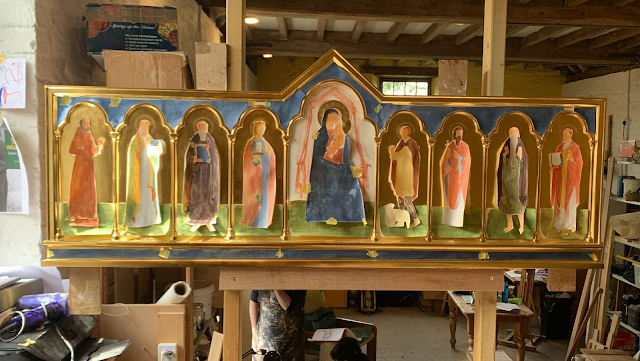The piece in question is an altarpiece painted in egg tempera that includes various saints and blesseds of Cumbria, a region located in the northwest of England. It was commissioned for a church located in this same region, the church of Our Lady and St. Michael's in Workington. (In other words, it is an altarpiece dedicated to local saints of the region in which it is found.)
In shape and style, this altarpiece is inspired by the later medieval form which, as we discussed in our series on the History and Forms of the Christian Altar, are the by product of the great age of the relics and the practice of standing up relic screens behind an altar. This would eventually evolve into the "retable." (If you would like a historical comparator, I would point you to the metallic 'screen' found behind the high altar of St. Mark's in Venice. This altarpiece falls into that same tradition.)

The frame itself comes in a very simple gothic style and is accented by deep blue highlight and gold gilt starts.
Personally, I believe it helps to increase one's appreciation for an art work, and the artistic process, if we also show some images of the work in progress. Fortunately, we have a number of such images of this particular altarpiece throughout its evolution from its beginnings until its completion.
 |
| The altarpiece is prepared with a white gessoed ground |
 |
| The figures are sketched in |
 |
| The gold leaf is applied around the figures |
 |
| Watercolours are here painted onto paper of the figures as well as the green and blue grounds, thus showcasing the projected colour compositions of the figures and how they interact with one another. |
 |
| The early, but as yet incomplete phase of the painting of the figures |
It is a spectacular and eye-catching altarpiece and demonstrative of the fact that work like this is yet still possible today.
-------

























